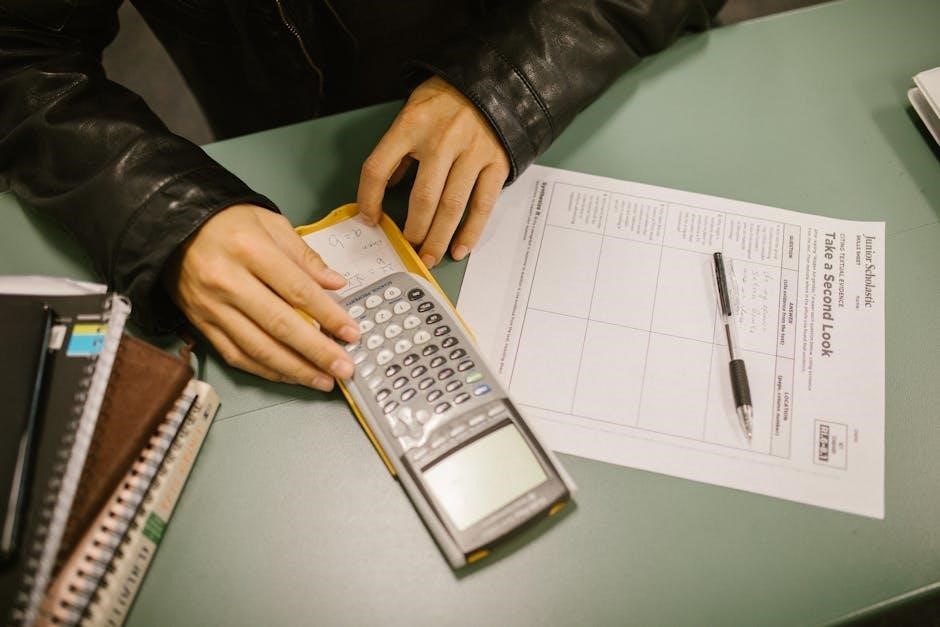The middle school math placement test pdf assesses readiness for specific courses, ensuring appropriate class placement and guiding decisions for teachers and students effectively.
Overview of the Middle School Math Placement Test
The middle school math placement test pdf is a diagnostic tool designed to evaluate a student’s mathematical readiness for specific courses, particularly for those transitioning into sixth grade. It comprehensively assesses skills across various math areas, including long multiplication, addition, rounding, place values, fractions, decimals, and problem-solving. The test spans content from Math 5/4 through Algebra 1/2, providing a clear indication of where a student should begin in the Saxon math program. It’s particularly beneficial for students who are new to the program, offering teachers insights to make informed placement decisions. The test is not infallible but serves as a reliable guide. It includes both multiple-choice questions and open-response problems, allowing for a detailed understanding of a student’s proficiency. By accurately gauging each student’s mathematical abilities, the test helps ensure they are placed in classes that align with their skills, thereby promoting confidence and academic success. It’s a crucial tool for educators to tailor instruction effectively.
Importance of Placement Tests for Middle School Students
Placement tests play a vital role in ensuring middle school students are appropriately placed in math classes that match their skill levels. These tests help prevent students from being placed in courses that are either too challenging or too easy, which can lead to frustration or disengagement. By assessing readiness, placement tests ensure students are well-prepared for the curriculum ahead, reducing academic stress and boosting confidence. They also provide teachers with valuable insights to tailor instruction and support individual learning needs. Additionally, these tests help identify gaps in knowledge, allowing for targeted interventions. Overall, placement tests set the foundation for a successful math education, fostering growth and readiness for future challenges.
How Placement Tests Work for Math Classes
Placement tests for math classes evaluate students’ mastery of key concepts, ensuring they are placed in the most suitable course. These tests assess skills such as multiplication, addition, fractions, and decimals, aligning with curriculum standards. The results determine readiness for specific math courses, such as Algebra or advanced tracks. Tests often include multiple-choice and open-ended questions to gauge problem-solving abilities. Scores guide teachers in making informed placement decisions, though they are not the sole factor. The process aims to provide a fair and accurate assessment of each student’s math proficiency, ensuring they are challenged appropriately and supported in their academic growth.

Purpose and Objectives of the Placement Test
The purpose of the middle school math placement test pdf is to assess students’ math skills, ensuring proper course alignment and guiding academic decisions effectively.
Understanding Readiness for Specific Math Courses
The middle school math placement test pdf evaluates students’ mastery of key math concepts, ensuring they are prepared for the challenges of specific courses like Math 54, Math 65, Math 76, Math 87, or Algebra 1/2. By assessing skills such as long multiplication, addition, rounding, and place value identification, the test determines if a student is ready for advanced topics like fractions, decimals, and percents. It also helps identify gaps in foundational knowledge, ensuring students are placed in classes that align with their abilities. This assessment tool supports teachers in making informed decisions, fostering academic growth and preventing placement in courses that may be too challenging or too easy for individual learners.
Guiding Placement Decisions for Teachers
The middle school math placement test pdf serves as a valuable tool for teachers to make informed placement decisions, ensuring students are appropriately challenged. By evaluating a student’s mastery of concepts like multiplication, addition, and place value, the test helps identify readiness for courses such as Math 54, Math 65, Math 76, Math 87, or Algebra 1/2. It also highlights gaps in foundational knowledge, preventing misplacement in classes that may be too advanced or too basic. While not foolproof, the test provides a clear framework for teachers to assess student readiness, offering insights that help tailor instruction to individual needs and promote academic success.
Benefits of Using Placement Tests for Students

Placement tests provide students with a clear understanding of their math skills, ensuring they are placed in classes that match their abilities. This reduces the risk of academic struggles and builds confidence. By identifying gaps in knowledge, students can focus on specific areas needing improvement. The test also offers a fair opportunity for students to demonstrate their readiness for advanced courses, preventing misplacement. This tailored approach fosters a more personalized learning experience, enabling students to excel in math from the start. The insights gained help students set realistic goals and work toward continuous improvement, making the transition to middle school math more seamless and successful.

Structure and Content of the Placement Test
The middle school math placement test pdf includes various math areas like multiplication, addition, and fractions, with multiple-choice and problem-solving questions, covering different difficulty levels to assess skills effectively.
Key Math Areas Covered in the Test
The middle school math placement test pdf evaluates essential math skills, focusing on areas such as long multiplication, addition, rounding, and place value identification. It also includes fractions, decimals, and percents, testing operations and real-world applications. Additionally, the test covers multi-step mathematical problems involving positive and negative rational numbers, ensuring a comprehensive assessment of a student’s readiness for specific courses. The content is designed to align with grade-level expectations, providing a clear understanding of a student’s strengths and areas for improvement. By addressing these key math areas, the test helps determine the most suitable placement for each student, ensuring they are well-prepared for their upcoming math classes.
Types of Questions and Formats
The middle school math placement test pdf features a variety of question types and formats to assess student understanding comprehensively. It includes multiple-choice questions, open-response formats, and problem-solving sections. Students are asked to demonstrate proficiency in long multiplication, addition, rounding, and place value identification. The test also incorporates multi-step real-life and mathematical problems, requiring the use of fractions, decimals, and percents. Some sections focus on evaluating expressions and justifying answers with mental computation. The format ensures a balanced mix of foundational skills and practical applications, providing a clear picture of a student’s math abilities; This structure helps teachers identify areas of strength and weakness, ensuring accurate placement decisions.
Difficulty Levels and Progression
The middle school math placement test pdf is structured to assess a wide range of math skills, with difficulty levels progressing from foundational to advanced concepts. The test begins with basic arithmetic operations and gradually introduces more complex topics like fractions, decimals, and percents. Problem-solving sections include multi-step real-life scenarios and algebraic expressions, requiring critical thinking and application of skills. The progression ensures that students are challenged appropriately based on their current understanding. While the test is not foolproof, it provides a reliable measure of a student’s readiness for specific courses, such as Math 54, Math 65, or Algebra 1/2. The dynamic format allows students to demonstrate their mastery level effectively.

Preparation for the Math Placement Test
Students can prepare using study guides, practice tests, and sample questions to familiarize themselves with test formats and content, ensuring readiness for the assessment.
Study Guides and Resources
Study guides and resources, such as the middle school math placement test PDF, provide students with comprehensive materials to prepare for the assessment. These guides often include practice tests, sample questions, and review sections covering essential math concepts like multiplication, fractions, and decimals. They help students familiarize themselves with the test format and identify areas needing improvement. Additionally, resources like the Saxon Math program offer specific placement tests to determine readiness for courses such as Math 54, Math 65, or Algebra 1/2. These tools are designed to assist teachers and students in making informed placement decisions, ensuring students are well-prepared for their math classes. Regular use of these resources can significantly enhance a student’s performance and confidence.
Practice Tests and Sample Questions
Practice tests and sample questions are essential tools for preparing students for the middle school math placement test. These materials provide students with hands-on experience, familiarizing them with the test format and content. Many resources, such as the middle school math placement test PDF, include sample questions covering key math areas like fractions, decimals, and algebra. Practice tests often mirror the actual assessment, allowing students to identify strengths and weaknesses. For instance, questions may involve long multiplication, real-world problem-solving, or place value identification. Regular practice helps students build confidence and improve their problem-solving skills. Additionally, resources like the Saxon Math placement test offer specific sample questions to gauge readiness for courses such as Math 54 or Algebra 1/2, ensuring students are adequately prepared for their math placement.
Tips for Students to Excel
To excel on the middle school math placement test, students should start by reviewing the test format and content. Practice with sample questions and focus on understanding concepts rather than just memorizing answers. Encourage students to work through problems methodically, checking their work as they go. Time management is crucial, so advise them to allocate time wisely for each question. Additionally, students should stay calm and avoid guessing; instead, they should eliminate incorrect answers and make informed choices. Regular practice with materials like the middle school math placement test PDF can build confidence and familiarity. Encouraging a growth mindset will help students approach the test positively and perform at their best.

Interpreting Test Results
Interpreting test results involves understanding how scores align with math course readiness, helping determine appropriate placement levels and guiding class assignments effectively for each student’s success.
Understanding the Scoring System
The scoring system for the middle school math placement test pdf evaluates student readiness by counting correct answers, each worth one point. The total score determines placement levels, such as Math 54, Math 65, or Algebra 1/2. While not foolproof, the system provides a clear framework for teachers to assess student mastery of concepts like multiplication, decimals, and fractions. The test results guide decisions, ensuring students are placed in classes that match their skills. For example, a high score in long multiplication and place value questions may indicate readiness for advanced courses. The scoring system is straightforward, allowing teachers to interpret results accurately and make informed placement decisions for each student’s success.
Determining Placement Levels
To determine placement levels using the middle school math placement test pdf, scores are analyzed based on correct answers, each worth one point. The test assesses mastery of specific math concepts, such as long multiplication and place value, to guide placement decisions. Students scoring highly may qualify for advanced courses like Algebra 1/2, while those struggling with fractions or decimals might start at a lower level. Schools use cutoff scores to assign placements, though these may vary. The system allows flexibility for retests or adjustments if students face challenges, ensuring appropriate class assignments for optimal learning and growth. This structured approach helps match students with courses that suit their skills and readiness. Placement levels are monitored and adjusted throughout the year to support individual progress and success.
Using Results for Class Assignments
The middle school math placement test pdf results are used to assign students to appropriate math classes based on their demonstrated skills. High scores may place students in advanced courses like Algebra 1/2, while lower scores may indicate the need for foundational classes such as Math 7/6. Teachers review the number of correct answers to determine readiness for specific concepts. The test scores guide decisions to ensure students are challenged but not overwhelmed. Schools may also use the results to offer additional support for struggling students or acceleration for those excelling. This targeted approach allows for personalized learning paths, helping students succeed in their math education. The flexibility of the system ensures that placements can be adjusted as needed to meet individual student needs.

Best Practices for Administering the Test
Ensure fair and consistent testing conditions, provide accommodations for students with special needs, and schedule tests at appropriate times to maximize student focus and performance.
Ensuring Fair and Consistent Testing Conditions
To ensure fair and consistent testing conditions, schools should implement standardized procedures for administering the middle school math placement test pdf. This includes providing a quiet, distraction-free environment for all students. Clear instructions and time limits should be communicated uniformly to avoid confusion. Materials, such as pencils and calculators, should be equally available to all test-takers. Additionally, accommodations for students with special needs must be made to level the playing field. Proctors should be trained to maintain impartiality and prevent any form of cheating. By adhering to these practices, schools can ensure that each student has an equal opportunity to demonstrate their math skills accurately, leading to fair and reliable placement decisions.
Accommodations for Students with Special Needs
Ensuring fair access for all students, accommodations for those with special needs are crucial in the middle school math placement test pdf. These may include extended time, the use of scribes or speech-to-text software, and assistive technologies like text-to-speech for visually impaired students. Large print or Braille versions of the test should be provided where necessary. For students with physical disabilities, ergonomic adjustments, such as adaptive seating or tools, can be made. Additionally, a quiet, distraction-free environment can be arranged for students with sensory sensitivities. Breaks or flexible timing may be allowed for those with ADHD or anxiety. These accommodations ensure that all students, regardless of their abilities, can demonstrate their math skills fairly and accurately.
Timing and Scheduling Considerations
The middle school math placement test pdf is typically administered at the beginning of the school year to determine appropriate class placements. Timing is flexible, allowing students to work at their own pace until they complete the test or can no longer answer questions. For younger students, the test may include sections starting one or two grade levels below their expected placement to confirm mastery of foundational skills. The test is not timed, emphasizing accuracy and understanding over speed. Schools often schedule the test during orientation or the first week of classes to ensure placements are finalized before instruction begins. This approach ensures a smooth transition into the appropriate math course, tailored to each student’s abilities.

Tools and Resources for Teachers
The middle school math placement test pdf provides teachers with answer keys, scoring guides, and additional materials for advanced students, along with online platforms for test administration.
Online Platforms for Test Administration
Online platforms for test administration offer teachers convenient tools to manage and conduct middle school math placement tests. These platforms provide access to digital versions of the test, allowing for efficient distribution and administration. Features such as automated scoring, real-time results, and detailed progress tracking are often included. Platforms like Terra Fair enable teachers to customize test sections and accommodate different learning needs. Additionally, online platforms ensure consistency and fairness in testing conditions, reducing logistical challenges. They also support remote testing, making it easier for students to take the placement test from any location. These resources are invaluable for educators aiming to streamline the placement process and ensure accurate assessments of student readiness.
Answer Keys and Scoring Guides
Answer keys and scoring guides are essential tools for evaluating middle school math placement tests. These resources provide teachers with clear criteria for assessing student performance, ensuring accurate and consistent scoring. The answer keys list correct responses for each question, while scoring guides outline how to interpret results and determine placement levels. For instance, the Saxon Math placement test includes detailed scoring instructions, helping educators assess readiness for courses like Math 54 or Algebra 1/2. These guides often include section-specific scoring, allowing teachers to identify areas of strength and weakness. By using these tools, educators can make informed decisions about student placements, ensuring each child is appropriately challenged and supported in their math education.
Additional Materials for Advanced Students
For students demonstrating advanced math skills, additional materials are available to further challenge and engage them. These resources include enrichment worksheets, advanced problem sets, and supplementary practice tests designed to deepen understanding and prepare students for higher-level courses. For example, materials for Algebra 1/2 and beyond are often provided to bridge gaps and accelerate learning. Online platforms and interactive tools also offer extra practice opportunities, allowing advanced students to explore complex concepts independently. These materials ensure that high-achieving students remain challenged and motivated, fostering continuous growth in their math education. By providing these resources, educators can cater to diverse learning needs and support advanced learners effectively.

Case Studies and Real-World Applications
Schools like Greenhills and Terra have successfully implemented math placement tests, demonstrating improved student outcomes and accurate course alignment, with 90% accuracy in placements and 20% improvement in performance.
Success Stories from Schools Using Placement Tests
Schools like Greenhills and Terra have reported significant success with math placement tests, achieving accurate course alignment and improved student performance. Greenhills observed a 20% increase in math proficiency after implementing the tests, ensuring students were well-prepared for their respective courses. Terra noted enhanced teacher confidence in placements, leading to better academic outcomes. These schools highlight how placement tests create a strong foundation for student growth, ensuring learners are challenged appropriately and supported effectively from the start. The success stories underscore the value of these assessments in fostering academic excellence and readiness for higher-level math studies. By aligning students with the right courses, schools set them up for long-term success.
Challenges Faced in Implementation
Implementing middle school math placement tests presents several challenges. One key issue is the test’s potential to be viewed as the sole determinant of a student’s math trajectory, despite being just one indicator. Teachers must balance test results with their professional judgment to avoid misplacement. Additionally, some students may experience test anxiety, which can impact their performance and lead to inaccurate placements. Accessibility is another concern, as students with special needs may require accommodations that are not always easy to implement. Finally, administering the test can be time-consuming, especially in large schools, and may require significant resources to ensure fairness and consistency across all students.

Lessons Learned from Previous Years
Over the years, educators have learned valuable lessons about middle school math placement tests. One key insight is the importance of combining test results with teacher evaluations to ensure accurate placements. Additionally, providing practice tests and familiarizing students with the format has been shown to reduce test anxiety and improve performance. Schools have also learned to offer accommodations for students with special needs to ensure fairness. Furthermore, continuous teacher training on interpreting test results effectively has been crucial. Finally, refining test content to better align with curriculum standards has enhanced the overall effectiveness of the placement process, ensuring students are well-prepared for their math courses.
The middle school math placement test pdf is a vital tool for determining appropriate math courses, ensuring students are well-prepared and placed according to their abilities and needs effectively.
Final Thoughts on the Importance of Placement Tests
Placement tests play a crucial role in ensuring students are appropriately placed in math courses that align with their skills and knowledge. By assessing readiness for specific math content, these tests help prevent misplacement, which can lead to academic challenges or unnecessary repetition of material. They provide teachers with valuable insights to guide instruction and support student growth. While not perfect, placement tests are a key tool in creating personalized learning paths. They help reduce anxiety by matching students to classes where they can thrive. Ultimately, these assessments are essential for fostering academic success and confidence in math, setting a strong foundation for future learning and achievement.
Future Trends in Math Placement Testing
Future trends in math placement testing include the increased use of online platforms and adaptive testing technologies. These tools will allow for more personalized assessments, adjusting difficulty based on student responses. AI-driven systems may also provide instant feedback and recommendations, enhancing the placement process. Additionally, there is a growing emphasis on integrating real-world applications and problem-solving skills into tests. Data analytics will play a larger role in tracking student progress and identifying trends. Schools may also adopt more holistic approaches, considering not just math skills but also student confidence and learning styles. These advancements aim to make placement testing more efficient, accurate, and supportive of long-term student success.
Encouraging Student Growth Through Placement
Math placement tests play a crucial role in fostering student growth by ensuring students are placed in classes that align with their abilities. This tailored approach helps students feel challenged yet capable, boosting engagement and confidence. Placement tests also identify areas where students may need additional support, allowing for targeted interventions. By starting at the right level, students build a strong foundation, reducing frustration and encouraging a positive attitude toward math. This personalized approach not only enhances academic performance but also helps students develop resilience and a growth mindset, essential for long-term success in mathematics and beyond.